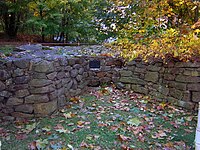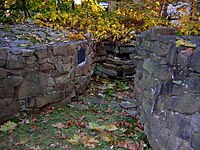| John Winthrop Jr. Iron Furnace Site | |
| U.S. National Register of Historic Places | |
 | |
  | |
| Nearest city | Quincy, Massachusetts |
|---|---|
| Coordinates | 42°14′44.8″N 71°1′37.5″W / 42.245778°N 71.027083°W / 42.245778; -71.027083 |
| Area | less than one acre |
| Built | 1644 |
| NRHP reference No. | 77000192 |
| Added to NRHP | September 20, 1977 |
The John Winthrop Jr. Iron Furnace Site is a historic archaeological site at 61 Crescent Street, Quincy, Massachusetts. The site is called Braintree Furnace in some texts; the West Quincy location at the time of operation was in a part of Braintree, Massachusetts, that later became Quincy. Its importance lies in the fact that it was the first iron blast furnace established in what would become the United States. Furnace Brook, a stream which begins on the eastern slopes of the Blue Hills and meanders for about four miles from southwest to northeast through the middle of Quincy toward Quincy Bay, was named for the works site.
The site was added to the National Register of Historic Places in 1977.
History
During the 17th century, iron was an used to manufacture a number of indispensable goods, including nails, horseshoes, cookware, tools, and weapons. The production of iron required a complex manufacturing process, which was not available during the early years of the North American colonization. Thus, all of the colonists iron goods had to be imported. As it took at least two months to sail to the nearest foundry, iron goods were very expensive.
John Winthrop the Younger wanted to establish an iron works in the Massachusetts Bay Colony. He believed that because the colonies had a cheap and abundant supply of raw materials, an iron works in Massachusetts could produce goods that could be sold profitably in the New England and Chesapeake Colonies as well as in England. In 1639, Winthrop sailed to England to get the capital he needed to fund the project. The Company of Undertakers for the Iron Workes in New England was founded to finance the venture. Winthrop selected Braintree as the location of the first iron furnace. Construction began in 1644 and was completed in 1645. On October 15, 1645, Winthrop secured the Undertakers an exemption from taxes and a 21-year monopoly on iron production from the Massachusetts General Court.
The Braintree iron furnace, however, was unsuccessful due to a lack of iron ore in the area and an inadequate supply of water to power the machinery. The furnace shut down in 1647, not long after the Saugus Iron Works was completed.
Several workers from the Braintree Furnace would go on to establish iron works in other locations. In the 1650s, James Leonard would help establish the Taunton Iron Works on the Two Mile River in Taunton, Massachusetts. His brother Henry Leonard would return to Saugus for a while before establishing a new works at Rowley in 1668. He would later move to New Jersey with his sons where several other works were built. Ralph Russell, another ironmaster from Braintree moved to Dartmouth where he set up a forge at what became known as Russells Mills, on the Paskamanset River.
Images
See also
References
- "National Register Information System". National Register of Historic Places. National Park Service. March 13, 2009.
- ^ Pattee, William S. (1879). A History of Old Braintree and Quincy: With a Sketch of Randolph and Holbrook. Green & Prescott. p. 458.
- "MHC Reconnaissance Survey Town Report: Quincy" (PDF). Massachusetts Historical Commission. 1981. pp. 4–5. Retrieved 12 December 2009.
- Hartley, E. N. (1957). Ironworks on the Saugus: The Lynn and Braintree Ventures of the Company of Undertakers of the Ironworks in New England. Norman, OK: University of Oklahoma Press. p. 10. ISBN 978-0-8061-0366-2. OCLC 48402155.
- ^ Gordon, John Steele (2009). An Empire of Wealth. HarperCollins. pp. 32–36.
- Fenton, John (November 14, 1954). "The Steel Mills' Ancestor". The New York Times.
- ^ "Saugus Iron Works 1647 Dedication Ceremony Program" (PDF). American Society of Mechanical Engineers. June 15, 1975. Archived from the original (PDF) on February 27, 2012. Retrieved July 16, 2014.
- The New England states, The New England states, D.H. Hurd & co., 1897
| U.S. National Register of Historic Places in Massachusetts | |||||||||||||||||
|---|---|---|---|---|---|---|---|---|---|---|---|---|---|---|---|---|---|
| Topics |  | ||||||||||||||||
| Lists by county | |||||||||||||||||
| Lists by city |
| ||||||||||||||||
| Other lists | |||||||||||||||||
- Industrial buildings and structures on the National Register of Historic Places in Massachusetts
- Quincy, Massachusetts
- National Register of Historic Places in Quincy, Massachusetts
- 1644 establishments in the Massachusetts Bay Colony
- Archaeological sites on the National Register of Historic Places in Massachusetts

